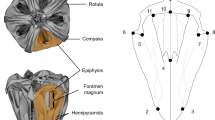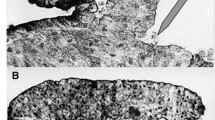Abstract
The nonlinear, complex nature of biosynthesis magnifies the impacts of small, random perturbations on organism growth, leading to distortions in adaptive allometries and, in particular, to fluctuating asymmetry. These distortions can be partly checked by cell-cell and inter-body part feedback during growth and development, though the latter mechanism also may lead to complex patterns in right-left asymmetry. Stress can be expected to increase the degree to which random growth perturbations are magnified and may also result in disruption of the check mechanisms, thus exaggerating fluctuating asymmetry.
The processes described not only provide one explanation for the existence of fluctuating asymmetry and its augmentation under stress, but suggest additional effects of stress as well. Specifically, stress is predicted to lead to decreased fractal dimension of bone sutures and branching structures in animals, and in increased dimension of growth trace patterns such as those found in mollusc shells and fish otoliths and scales.
A basic yet broad primer on fractals and chaos is provided as background for the theoretical development in this manuscript.
Similar content being viewed by others
References
Alekseeva, T. A., V. V. Zinichev & A. I. Zotin, 1992. Energy criteria of reliability and stability of development. Acta Zool. Fennica 191: 159–165.
Adams, M. S. & J. D. Niswander, 1967. Developmental ‘noise’ and a congenital malformation. Genet. Res. 10: 313–317.
Agladze, K., E. Dulos & P. De Kepper, 1992. Turing patterns in confined gel and gel-free media J. Phys. Chem. 96: 2400–2403.
Alados, C. L., J. Escos & J. M. Emlen, 1992. Developmental instability as an indicator of stress in the Pacific hake (Merluccius productus). Fishery Bulletin (in press).
Ames, L. J., J. D. Felley & M. H. Smith, 1979. Amounts of asymmetry in centrarchid fish inhabiting heated and non-heated reservoirs. Trans. Amer. Fish. Soc. 108: 489–485.
Bader, R. S., 1965. Fluctuating asymmetry in the dentition of the house mouse. Growth 29: 291–300.
Bailit, H. L., P. L. Workman, J. D. Niswander & C. J. MacLean, 1970. Dental asymmetry as an indicator of genetic and environmental conditions in human populations. Hum. Biol. 42: 626–638.
Barden, H. S., 1980. Fluctuating dental asymmetry: a measure of developmental instability in Down syndrome. Amer. J. Phys. Anthro. 52: 169–173.
Castets, V., E. Dulos, J. Boissonade & P. De Kepper, 1990. Experimental evidence of a sustained standing Turing-type nonequilibrium chemical pattern. Phys. Rev. Lett. 64: 2953–2956.
Clarke, G. M., 1992. Fluctuating asymmetry: A technique for measuring developmental stress of genetic and environmental origin. Acta Zool. Fennica 191: 31–36.
Clarke, G. M., B. P. Oldroyd & P. Hunt, 1992. The genetic basis of developmental stability inApis mellifera: Heterozygosity versus genic balance. Evolution 46: 753–762.
DiBennardo, R. & H. L. Bailit, 1978. Stress and dental asymmetry in a population of Japanese children. Amer. J. Phys. Anthro. 48: 89–94.
Eilbeck, J. C., 1989. Pattern formation and pattern selection in reaction-diffusion systems, pp. 31–41 in Theoretical Biology: Epigenetic and Evolutionary Order from Complex Systems, edited by B. Goodwin and P. Saunders. Edinburgh University Press.
Feder, J., 1988. Fractals. Plenum Press, New York, 283 pp.
Felley, J., 1980. Analysis of morphology and asymmetry in bluegill sunfish (Lepomis machrochirus) in the southeastern United States. Copeia 1980: 18–29.
Freeman, D. C., J. H. Graham & J. M. Emlen, 1993. (This volume).
Graham, J. H., 1992. Genomic coadaptation and developmental stability in hybrid zones. Acta Zool. Fenn. 192: 121–132.
Graham, J. H. & J. D. Felley, 1985. Genomic coadaptation and developmental stability within introgressed population ofEnneacanthus gloriosus andE. obesus (Pisces, Centrarchidae). Evolution. 39: 104–114.
Graham, J. H., D. C. Freeman & J. M. Emlen, 1993. (This volume).
Gumowski, I., 1987. Oscillatory plant transpiration: Problem of a mathematically correct model, pp. 13–18 in Chaos in Biological Systems, NATO ASI series, edited by H. D Fegn, A. V. Holden and L. F. Olson. Plenum Press, New York.
Harris, E. F. & M. T. Nweeia, 1980. Dental asymmetry as a measure of environmental stress in the Ticuna Indians of Columbia. Amer. J. Phys. Anthro. 53: 133–142.
Hartwig, W. C., 1991. Fractal analysis of sagittal suture morphology. J. Morphology 210: 289–298.
Hess, B. & A. Boiteux, 1971. Oscillatory phenomena in biochemistry. Ann. Rev. Biochem. 40: 237–258.
Ivanovics, A. M. & W. J. Wiebe, 1981. Toward a working definition of stress: A review and critique, pp. 13–27 in Stress Effects on Natural Ecosystems, edited by G. W. Barrett and R. Rosenberg. Wiley and Sons, Ltd.
Jagoe, C. H. & T. A. Haines, 1985. Fluctuating asymmetry in fishes inhabiting acidified and unacidified lakes. Can. J. Zool. 63: 130–138.
Kieser, J. A., H. T. Groeneveld & C. B. Preston, 1986. Fluctuating dental asymmetry as a measure of odontogenic canalization in Man. Amer. J. Phys. Anthro. 71: 437–444.
Koji, T., P. K. Nakane, M. Murakoski, K. Watanabe & H. Terayama, 1988. Cell density dependent morphological changes in adult rat hepatocytes during primary culture. Cell Biochem. and Function 6: 237–243.
Lampl, M., J. D. Veldhuis & M. L. Johnson, 1992. Saltation and stasis: A model of human growth. Science 258: 801–803.
Leary, R. F., F. W. Allendorf & K. L. Knudsen, 1985. Developmental instability as an indicator of reduced genetic variation in hatchery trout. Trans. Amer. Fish. Soc. 114: 230–235.
Lehninger, A. L., 1971. Bioenergetics, the Molecular Basis of Biological Energy Transformations. W. A. Benjamin, Inc., 245 pp.
Maini, P. K., M. R. Myerscough, K. H. Winters & J. D. Murray, 1991. Bifurcating spatially heterogeneous solutions in a chemotaxis model for biological pattern generation. J. Math. Biol. 53: 701–719.
Mandelbrot, B., 1982. The fractal Geometry of Nature. W. H. Freeman, New York.
Manley, S. A. M. & F. T. Ledig, 1979. Photosynthesis in black and red spruce and their hybrid derivations: ecological isolation and hybrid adaptive inferiority. Can. J. Bot. 57: 307–314.
Markow, T. A. & I. I. Gottesman, 1989. Fluctuating dermatoglyphic asymmetry in psychotic twins. Psychiatry Res. 29: 37–43.
Mather, K., 1953. Genetical control of stability in development. Heredity 7: 297–336.
Meinhardt, H., 1982. Models of Biological Pattern Formation. Academic Press, 230 pp.
Miller, J. R. & J. Giroux, 1966. Dermatoglyphics in pediatric practice, J. Pediatrics 69: 302–312.
Nagorcka, B. N., 1989. Wavelike isomorphic prepatterns in development. J. Theoret. Biol. 137: 127–162.
Ozernyuk, N. D., V. I. Dyomin, E. A. Prokofyev & I. M. Androsova, 1992. Energy, homeostasis and developmental stability. Acta Zool. Fennica 191: 167–175.
Parsons, P. A., 1992. Fluctuating asymmetry: a biological monitor of environmental and genomic stress. Heredity 68: 361–364.
Pritchard, J. J., J. H. Scott & F. G. Girgis, 1956. The structure and development of cranial and facial sutures. J. Anat. 90: 73–86.
Shapiro, B. L., 1983. Down syndrome. A disruption of homeostasis. Amer. J. Med. Genet. 14: 241–269.
Shiono, H. & J. Kadowaki, 1975. Dermatoglyphics of congenital abnormalities without chromosomal aberrations. Clim. Pediatr. 14: 1003–1013.
Siegel, M. I. & W. J. Doyle, 1975. Stress and fluctuating limb asymmetry in various species of rodents. Growth 39: 363–369.
Sofaer, J. A., 1979. Human tooth-size asymmetry in cleft lip with or without cleft palate. Arch. Oral Biol. 24: 141–146.
Soule, M. E., 1967. Phenetics of natural populations, II. Asymmetry and evolution in a lizard. Amer. Natur. 101: 141–160.
Soule, M. E., 1982. Allomeric variation. 1. The theory and some consequences. Amer. Natur. 120: 751–764.
Soule, M. E. & J. Cuzin-Roudy, 1982. Allomeric variation. 2. Developmental instability of extreme phenotypes. Amer. Natur. 120: 765–786.
Terayama, H., H. Otsuka, K. Sakuma & H. Yamagata, 1969. Molecular aspects of the release of tumor cells from the control of proliferation, pp. 327–336 in Nucleic Acid Metabolism, Cell Differentiation and Cancer Growth, edited by E. V. Cowdry and S. Seno. Pergamon Press, New York.
Thoday, J. M., 1958. Homeostasis in a selection experiment. Heredity 12: 401–415.
Turkington, R. W., 1971. Hormonal regulation of cell proliferation and differentiation, pp. 315–355, in Developmental Aspects of the Cell Cycle, edited by I. L. Cameron, G. M. Padilla and A. M. Zimmerman. Academic Press, London.
Valentine, D. W., M. E. Soule & P. Samollow, 1973. Asymmetry analysis in fishes: A possible statistical indicator of environmental stress. Fish. Bull. 71: 357–370.
Walker, D. G., 1961. Malformations of the Face. Livingstone, London.
Wedemeyer, G. A., B. Burton & D. McLeay, 1990. Stress and Acclimation, pp. 451–490 in Methods for Fish Biology, edited by C. Schreck and P. Moyle. Amer. Fisheries Society, Bethesda, Maryland.
West, B. J., Fractal Physiology and Chaos in Medicine World. Scientific.
Woolf, C. M. & A. D. Gianas, 1976. Congenital cleft lip and fluctuating dermatoglyphic asymmetry. Amer. J. Hum. Genet. 28: 400–403.
Woolf, C. M. & A. D. Gianas, 1977. A study of fluctuating dermatoglyphic asymmetry in the sibs and parents of cleft lip propositi. Amer. J. Hum. Genet. 29: 503–507.
Zakharov, V. M. & E. D. Bakulina, 1984. Disturbance of developmental stability at crossing different strains ofDrosophila virilis (variation in the number of ovarioles taken as an example), Genetika 20: 1390–1391 (in Russian).
Zakharov, V. M. & G. I. Rubin, 1985. The disturbance of developmental stability as an indicator of anthropogenic influence on animal populations in the Baltic Sea basin pp. 526–536 in Symp. on Ecol. Investig. of the Baltic Sea Environment. Riga, USSR, 1983, Valkion Paintuskeskus, Helsinki.
Author information
Authors and Affiliations
Rights and permissions
About this article
Cite this article
Emlen, J.M., Freeman, D.C. & Graham, J.H. Nonlinear growth dynamics and the origin of fluctuating asymmetry. Genetica 89, 77–96 (1993). https://doi.org/10.1007/BF02424507
Accepted:
Issue Date:
DOI: https://doi.org/10.1007/BF02424507




